Particle-Laden Two-Phase Boundary Layer: A Review
Abstract
1. Introduction
- (i)
- Changes in the structure of the two-phase flow approaching the body;
- (ii)
- Changes in the boundary layer (BL) developing on the body;
- (iii)
- Changes in turbulent wakes and vortexes;
- (iv)
- Particle collisions with the surface;
- (v)
- Changes in surface roughness, etc.
- (i)
- particle deceleration in the near-wall region;
- (ii)
- particle–wall interactions;
- (iii)
- interparticle interactions;
- (iv)
- “ejection” and “sweep” events, etc.
2. Dimensionless Parameters of Two-Phase Boundary Layers
2.1. Dimensionless Characteristics of Two-Phase Boundary Layers
- (i)
- Particles obey Stokes’ drag law (Stokesian particles);
- (ii)
- Particles have unit density ρp = 1000 kg/m3;
- (iii)
- Velocity relaxation completes () when the Stokes number reaches Stkf = 0.2;
- (iv)
- The carrier gas has constant dynamic viscosity µ = 18·10−6 kg/(m·s).
2.2. Other Dimensionless Parameters
2.3. Numerical Simulation of Two-Phase Boundary Layers
- (i)
- Single-particle regime (), where their presence does not affect the carrier gas characteristics (“one-way coupling”, OWC);
- (ii)
- (iii)
3. Two-Phase Laminar Boundary Layers
3.1. Particle Motion in Two-Phase Laminar Boundary Layers
3.2. Particles’ Back Influence on Two-Phase Laminar Boundary Layers
4. Stability of the Two-Phase Boundary Layer. Transitional Region
4.1. Stability of Two-Phase Laminar Boundary Layers
4.2. Particles’ Influence on the Laminar–Turbulent Transition
5. Two-Phase Turbulent Boundary Layers
5.1. Particle Motion in Two-Phase Turbulent Boundary Layers
5.2. Particles’ Back Influence on Two-Phase Turbulent Boundary Layers
6. Conclusions
- (i)
- Studying the effect of particles on various types of instabilities and laminar–turbulent transitions in the boundary layer with changes in the inertia and concentration of the dispersed phase in a wide range;
- (ii)
- The study of local areas of increased concentration (clustering effect) and the associated need to consider the inverse (back) effect of particles (TWC) and interparticle collisions (FWC);
- (iii)
- Developing methods for the numerical simulation of two-phase flows with interphase boundary resolution (PR) and comparing the results obtained with the results of calculations obtained using the point particle (PP) method.
Author Contributions
Funding
Data Availability Statement
Acknowledgments
Conflicts of Interest
References
- Boothroyd, R.G. Flowing Gas-Solids Suspensions; Chapman and Hall: London, UK, 1971. [Google Scholar]
- Sukomel, A.S.; Tsvetkov, F.F.; Kerimov, R.V. Heat Transfer and Hydraulic Resistance in the Motion of Gas Suspension in Pipes; Energiya: Moscow, Russia, 1977. (In Russian) [Google Scholar]
- Soo, S.L. Particulates and Continuum: Multiphase Fluid Dynamics; Hemisphere: Berlin, Germany; New York, NY, USA, 1989; 400p. [Google Scholar]
- Volkov, E.P.; Zaichik, L.I.; Pershukov, V.A. Simulation of the Combustion of Solid Fuels; Nauka: Moscow, Russia, 1994; 320p. (In Russian) [Google Scholar]
- Fan, L.-S.; Zhu, C. Principles of Gas-Solid Flows; Cambridge University Press: New York, NY, USA, 1998. [Google Scholar]
- Crowe, C.; Sommerfeld, M.; Tsuji, Y. (Eds.) Multiphase Flows with Droplets and Particles; CRC Press: Boca Raton, FL, USA, 1998; 471p. [Google Scholar]
- Varaksin, A.Y. Turbulent Particle-Laden Gas Flows; Springer: New York, NY, USA, 2007; 210p. [Google Scholar]
- Mikhatulin, D.S.; Polezhaev, Y.V.; Reviznikov, D.L. Heat Transfer and Destruction of Bodies in Supersonic Heterogeneous Flow; Yanus-K: Moscow, Russia, 2007; 392p. (In Russian) [Google Scholar]
- Varaksin, A.Y. Collisions in Particle-Laden Gas Flows; Begell House: New York, NY, USA, 2013; 370p. [Google Scholar]
- Michaelides, E.E.; Crowe, C.T.; Schwarzkopf, J.D. (Eds.) Multiphase Flow Handbook; CRC Press: Boca Raton, FL, USA, 2016. [Google Scholar]
- Osiptsov, A.N. Mathematical modeling of dusty-gas boundary layers. Appl. Mech. Rev. 1997, 50, 357–370. [Google Scholar] [CrossRef]
- Liu, J.T.C. Flow induced by an oscillating infinite flat plate in a dusty gas. Phys. Fluids 1966, 9, 1716–1720. [Google Scholar] [CrossRef]
- Liu, J.T.C. Flow induced by the impulsive motion of an infinite flat plate in dusty gas. Astronaut. Acta. 1967, 13, 369–377. [Google Scholar]
- Marble, F.E. Dynamics of Dusty Gases. Annu. Rev. Fluid Mech. 1970, 2, 397–446. [Google Scholar] [CrossRef]
- Varaksin, A.Y.; Ryzhkov, S.V. Mathematical modeling of gas-solid two-phase flows: Problems, achievements and perspectives (a review). Mathematics 2023, 11, 3290. [Google Scholar] [CrossRef]
- Dorgan, A.J.; Loth, E. Simulation of particles released near the wall in a turbulent boundary layer. Int. J. Multiph. Flow 2004, 30, 649–673. [Google Scholar] [CrossRef]
- Riley, J.J.; Patterson, G.S., Jr. Diffusion experiments with numerically integrated isotropic turbulence. Phys. Fluids 1974, 17, 292–297. [Google Scholar] [CrossRef]
- Yeung, P.K.; Pope, S.B. An algorithm for tracking fluid particles in numerical simulation of homogeneous turbulence. J. Comput. Phys. 1988, 79, 373–416. [Google Scholar] [CrossRef]
- Balachandar, S.; Maxey, M.R. Methods for evaluating fluid velocities in spectral simulations of turbulence. J. Comput. Phys. 1989, 83, 96–125. [Google Scholar] [CrossRef]
- Burton, T.M.; Eaton, J. Fully resolved simulations of particle-turbulence interaction. J. Fluid Mech. 2005, 545, 67–111. [Google Scholar] [CrossRef]
- Picano, F.; Breugem, W.P.; Brandt, L. Turbulent channel flow of dense suspensions of neutrally-buoyant spheres. J. Fluid Mech. 2015, 764, 463–487. [Google Scholar] [CrossRef]
- Cate, A.T.; Derksen, J.J.; Portela, L.M.; van den Akker, H.E.A. Fully resolved simulations of colliding monodisperse spheres in forced isotropic turbulence. J. Fluid Mech. 2004, 539, 233–271. [Google Scholar] [CrossRef]
- Takagi, S.; Oguz, H.N.; Zhang, Z.; Prosperetti, A. Physalis: A new method for particle simulation: Part ii: Two-dimensional Navier-Stokes flow around cylinders. J. Comput. Phys. 2003, 187, 371–390. [Google Scholar] [CrossRef]
- Elghobashi, S. Direct numerical simulation of turbulent flows laden with droplets or bubbles. Annu. Rev. Fluid Mech. 2019, 51, 217–244. [Google Scholar] [CrossRef]
- Elghobashi, S. Particle-laden turbulent flows. Appl. Sci. Res. 1991, 48, 301–314. [Google Scholar] [CrossRef]
- Elghobashi, S. On predicting particle-laden turbulent flows. Appl. Sci. Res. 1994, 52, 309–329. [Google Scholar] [CrossRef]
- Vreman, A.W. Turbulence characteristics of particle-laden pipe flow. J. Fluid Mech. 2007, 584, 235–279. [Google Scholar] [CrossRef]
- Eaton, J.K. Two-way coupled turbulence simulations of gas–particle flows using point-particle tracking. Int. J. Multiph. Flow 2009, 35, 792–800. [Google Scholar] [CrossRef]
- Vreman, A.W. Turbulence attenuation in particle-laden flow in smooth and rough channels. J. Fluid Mech. 2015, 773, 103–136. [Google Scholar] [CrossRef]
- Varaksin, A.Y.; Ryzhkov, S.V. Turbulence in two-phase flows with macro-, micro-, and nanoparticles: A review. Symmetry 2022, 14, 2433. [Google Scholar] [CrossRef]
- Saffman, P.G.; Turner, J.S. On the collision of drops in turbulent cloud. J. Fluid Mech. 1956, 1, 16–30. [Google Scholar] [CrossRef]
- Wang, L.-P.; Wexler, A.S.; Zhou, Y. On the collision rate of small particles in isotropic turbulence. I. Zero-inertia case. Phys. Fluids 1998, 10, 266–276. [Google Scholar] [CrossRef]
- Wang, L.-P.; Wexler, A.S.; Zhou, Y. Statistical mechanical description and modelling of turbulent collision of inertial particles. J. Fluid Mech. 2000, 415, 117–153. [Google Scholar] [CrossRef]
- Kuerten, J.G.M.; Vreman, A.W. Effect of droplet interaction on droplet-laden turbulent channel flow. Phys. Fluids 2015, 27, 053304. [Google Scholar] [CrossRef]
- Varaksin, A.Y. Collision of particles and droplets in turbulent two-phase flows. High Temp. 2019, 57, 555–572. [Google Scholar] [CrossRef]
- Varaksin, A.Y. Interparticle collisions in turbulent two-phase flows. High Temp. 2024, 62, 400–413. [Google Scholar] [CrossRef]
- Soo, S.L. Laminar and separated flow of a particulate suspension. Astronautica Acta. 1965, 11, 422–431. [Google Scholar]
- Osiptsov, A.N. Structure of the laminar boundary layer of a disperse medium on a flat plate. Fluid Dyn. 1980, 15, 512–517. [Google Scholar] [CrossRef]
- Nigmatulin, R.I. Fundamentals of the Mechanics of Heterogeneous Media; Nauka Press: Moscow, Russia, 1978; 336p. (In Russian) [Google Scholar]
- Osiptsov, A.N. Investigation of regions of unbounded growth of the particle concentration in disperse flows. Fluid Dyn. 1984, 19, 378–385. [Google Scholar] [CrossRef]
- Osiptsov, A.N. Motion of a dusty gas at the entrance to a flat channel and a circular pipe. Fluid Dyn. 1988, 23, 867–874. [Google Scholar] [CrossRef]
- Naumov, V.A. Calculation of the laminar boundary layer on a plate with allowance for the lifting forces acting on a dispersed mixture. Fluid Dyn. 1988, 23, 943–945. [Google Scholar] [CrossRef]
- Varaksin, A.Y.; Ivanov, T.F. Pseudolaminar boundary layer on a blunt body subjected to a heterogeneous flow. High Temp. 2004, 42, 73–78. [Google Scholar] [CrossRef]
- Rogers, C.B.; Eaton, J.K. The behavior of small particles in a vertical turbulent boundary layer in air. Int. J. Multiph. Flow 1990, 16, 819–834. [Google Scholar] [CrossRef]
- Kulick, J.D.; Fessler, J.R.; Eaton, J.K. Particle response and turbulence modification in fully developed channel flow. J. Fluid Mech. 1994, 277, 109–134. [Google Scholar] [CrossRef]
- Asmolov, E.S. Dusty-gas flow in a laminar boundary layer over a blunt body. J. Fluid Mech. 1995, 305, 29–46. [Google Scholar] [CrossRef]
- Wang, B.Y.; Glass, I.J. Compressible laminar boundary-layer flows of a dusty gas over a semi-infinite flat plate. J. Fluid Mech. 1988, 186, 223–241. [Google Scholar] [CrossRef]
- Singleton, R.E. Compressible gas-solid particle flow over a semi-infinite flat plate. Z. Angew. Math. Phys. 1965, 16, 421–449. [Google Scholar] [CrossRef]
- Varaksin, A.Y.; Mikhatulin, D.S.; Polezhaev, Y.V.; Polyakov, A.F. Measurements of velocity fields of gas and solid particles in the boundary layer of turbulized heterogeneous flow. High Temp. 1995, 33, 911–917. [Google Scholar]
- Grek, G.R.; Kozlov, V.V.; Ramazanov, M.P. Laminar-turbulent transition in the presence of a high level of free-stream turbulence. Fluid Dyn. 1988, 23, 829–834. [Google Scholar] [CrossRef]
- Leib, S.J.; Wundrow, D.W.; Goldstein, M.E. Effects of free-stream turbulence and other vertical disturbances on a laminar boundary layer. J. Fluid Mech. 1999, 380, 169–203. [Google Scholar] [CrossRef]
- Zhigulev, S.V.; Uspenskii, A.A.; Ustinov, M.V. Effect of the freestream turbulence scale and the leading edge shape on boundary layer laminar-turbulent transition. Fluid Dyn. 2009, 44, 31–44. [Google Scholar] [CrossRef]
- Tumin, A.M.; Fedorov, A.V. Istability wave excitation by a localized vibrator in the boundary layer. J. Appl. Mech. Tech. Phys. 1984, 25, 867–873. [Google Scholar] [CrossRef]
- Manuilovich, S.V. Excitation of Tollmien-Schlichting waves by a vibrating section of a surface with flow around it. Fluid Dyn. 1987, 22, 532–537. [Google Scholar] [CrossRef]
- Manuilovich, S.V. Disturbances of a three-dimensional boundary layer generated by surface roughness. Fluid Dyn. 1989, 24, 764–769. [Google Scholar] [CrossRef]
- Schneider, S.P. Effect of roughness on hypersonic boundary layer transition. J. Spacecr. Rocket. 2008, 45, 193–209. [Google Scholar] [CrossRef]
- Kazakov, A.V.; Kogan, M.N. Stability of subsonic laminar boundary layer on a flat plate with volume energy supply. Fluid Dyn. 1988, 23, 211–215. [Google Scholar] [CrossRef]
- Dovgal’, A.V.; Levchenko, V.Y.; Timofeev, V.A. Boundary layer laminarization by local surface heating. Izv. Sib. Otd. Akad. Nauk SSSR Ser. Tekh. Nauk 1989, 60–65. [Google Scholar]
- Druzhinin, O.A.; Elghobashi, S. On the decay rate of isotropic turbulence laden with microparticles. Phys. Fluids 1999, 11, 602–610. [Google Scholar] [CrossRef]
- Druzhinin, O.A. The influence of particle inertia on the two-way coupling and modification of isotropic turbulence by microparticles. Phys. Fluids 2001, 13, 3738–3755. [Google Scholar] [CrossRef]
- Zaichik, L.I.; Alipchenkov, V.M.; Kozlov, I.M. Simulation of the effect of finely divided particles on turbulence. High Temp. 2010, 48, 205–214. [Google Scholar] [CrossRef]
- Saffman, P.G. On the stability of laminar flow of a dusty gas. J. Fluid Mech. 1962, 13, 120–128. [Google Scholar] [CrossRef]
- Schlichting, H. Boundary Layer Theory; McGraw-Hill: New York, NY, USA, 1968. [Google Scholar]
- Asmolov, E.S.; Manuilovich, S.V. Stability of a dusty-gas laminar boundary layer on a flat plate. J. Fluid Mech. 1998, 365, 137–170. [Google Scholar] [CrossRef]
- Abramovich, G.N. The effect of solid particle or drop addition on the structure of a turbulent gas jet. Dokl. Akad. Nauk SSSR 1970, 190, 1052–1055. (In Russian) [Google Scholar]
- Yarin, L.P.; Hetsroni, G. Turbulence intensity in dilute two-phase flows—1. Effect of particle-size distribution on the turbulence of the carrier fluid. Int. J. Multiph. Flow 1994, 20, 1–15. [Google Scholar] [CrossRef]
- Yarin, L.P.; Hetsroni, G. Turbulence intensity in dilute two-phase flows—2. Temperature fluctuations in particle-laden dilute flows. Int. J. Multiph. Flow 1994, 20, 17–25. [Google Scholar] [CrossRef]
- Yarin, L.P.; Hetsroni, G. Turbulence intensity in dilute two-phase flows—3. The particles-turbulence interaction in dilute two-phase flow. Int. J. Multiph. Flow 1994, 20, 27–44. [Google Scholar] [CrossRef]
- Varaksin, A.Y.; Zaichik, L.I. The effect of a fine divided impurity on the turbulence intensity of a carrier flow in a pipe. High Temp. 1998, 36, 983–986. [Google Scholar]
- Pakhomov, M.A.; Protasov, M.V.; Terekhov, V.I.; Varaksin, A.Y. Experimental and numerical investigation of downward gas-dispersed turbulent pipe flow. Int. J. Heat Mass Transfer 2007, 50, 2107–2116. [Google Scholar] [CrossRef]
- Yuan, Z.; Michaelides, E.E. Turbulence modulation in particulate flows—A theoretical approarch. Int. J. Multiph. Flow 1992, 18, 779–785. [Google Scholar] [CrossRef]
- Zaichik, L.I.; Varaksin, A.Y. Effect of the wake behind large particles on the turbulence intensity of carrier flow. High Temp. 1999, 37, 655–658. [Google Scholar]
- Fedorov, A.V. Receptivity of a supersonic boundary layer to solid particulates. J. Fluid Mech. 2013, 737, 105–131. [Google Scholar] [CrossRef]
- Chuvakov, P.V.; Fedorov, A.V.; Obraz, A.O. Numerical modelling of supersonic boundary-layer receptivity to solid particulates. J. Fluid Mech. 2019, 859, 949–971. [Google Scholar] [CrossRef]
- Reeks, M.W. On the dispersion on small particles suspended in an isotropic turbulent field. J. Fluid Mech. 1977, 83, 529–546. [Google Scholar] [CrossRef]
- Reeks, M.W. The transport of discrete particles in inhomogeneous turbulence. J. Aerosol Sci. 1983, 14, 729–739. [Google Scholar] [CrossRef]
- Shin, M.; Lee, J.W. Memory effect in the Eulerian particle deposition in a fully developed turbulent channel flow. J. Aerosol Sci. 2001, 32, 675–693. [Google Scholar] [CrossRef]
- Shin, M.; Kim, D.S.; Lee, J.W. Deposition of inertia-dominated particles inside a turbulent boundary layer. Int. J. Multiph. Flow 2003, 29, 893–926. [Google Scholar] [CrossRef]
- Li, D.; Wei, A.; Luo, K.; Fan, J. Direct numerical simulation of a particle-laden flow in a flat plate boundary layer. Int. J. Multiph. Flow 2016, 79, 124–143. [Google Scholar] [CrossRef]
- Li, D.; Luo, K.; Fan, J. Particle statistics in a two-way coupled turbulent boundary layer flow over a flat plate. Powder Technol. 2017, 305, 250–259. [Google Scholar] [CrossRef]
- Li, D.; Luo, K.; Fan, J. Translational and rotational motions of small solid particles in a spatially developing turbulent boundary layer with heat transfer. Int. J. Heat Mass Transf. 2018, 124, 715–725. [Google Scholar] [CrossRef]
- Luo, K.; Dai, Q.; Liu, X.; Fan, J. Effects of wall roughness on particle dynamics in a spatially developing turbulent boundary layer. Int. J. Multiph. Flow 2019, 111, 140–157. [Google Scholar] [CrossRef]
- Li, D.; Luo, K.; Fan, J. Modulation of turbulence by dispersed solid particles in a spatially developing flat-plate boundary layer. J. Fluid Mech. 2016, 802, 359–394. [Google Scholar] [CrossRef]
- Taniere, A.; Oesterle, B.; Monnier, J.C. On the behaviour of solid particles in a horizontal boundary layer with turbulence and saltation effects. Exp. Fluids 1997, 23, 463–471. [Google Scholar] [CrossRef]
- Yu, M.; Zhao, L.; Yuan, X.; Xu, C. Transport of inertial spherical particles in compressible turbulent boundary layers. J. Fluid Mech. 2024, 990, A5. [Google Scholar] [CrossRef]
- Rogers, C.B.; Eaton, J.K. Particle response and turbulent modification in a flat plate turbulent boundary layer. In Turbulence Modification in Dispersed Multiphase Flows; ASME: New York, NY, USA, 1989; Volume 80, pp. 15–22. [Google Scholar]
- Wang, J.; Levy, E.K. Particle motions and distributions in turbulent boundary layer of air-particle flow past a vertical flat plate. Exp. Therm. Fluid Sci. 2003, 27, 845–853. [Google Scholar] [CrossRef]
- Wang, J.; Levy, E.K. Particle behavior in the turbulent boundary layer of a dilute gas-particle flow past a flat plate. Exp. Therm. Fluid Sci. 2006, 30, 473–483. [Google Scholar] [CrossRef]
- Berk, T.; Coletti, F. Transport of inertial particles in high-Reynolds-number turbulent boundary layers. J. Fluid Mech. 2020, 903, A18. [Google Scholar] [CrossRef]
- Berk, T.; Coletti, F. Dynamics and scaling of particle streaks in high-Reynolds-number turbulent boundary layers. J. Fluid Mech. 2023, 975, A47. [Google Scholar] [CrossRef]
- Kim, T. Experimental investigation of particle dynamics in particle-laden turbulent boundary layer. Int. J. Mechan. Sci. 2024, 263, 108757. [Google Scholar] [CrossRef]
- Li, D.; Luo, K.; Fan, J. Direct numerical simulation of turbulent flow and heat transfer in a spatially developing turbulent boundary layer laden with particles. J. Fluid Mech. 2018, 845, 417–461. [Google Scholar] [CrossRef]
- Chen, G.; Wang, H.; Luo, K.; Fan, J. Two-way coupled turbulent particle-laden boundary layer combustion over a flat plate. J. Fluid Mech. 2022, 948, A12. [Google Scholar] [CrossRef]
- Rogers, C.B.; Eaton, J.K. The effect of small particles on fluid turbulence in a flat-plate, turbulent boundary layer in air. Phys. Fluids A 1991, 3, 928–937. [Google Scholar] [CrossRef]
- Li, J.; Wang, H.; Liu, J.; Chen, S.; Zheng, C. An experimental study on turbulence modification in the ear-wall boundary layer of a dilute gas-particle channel flow. Exp. Fluids 2012, 53, 1385–1403. [Google Scholar] [CrossRef]
- Moin, P.; Kim, J. The structure of the vorticity field in turbulent channel flow. Part 1. Analysis of instantaneous fields and statistical correlations. J. Fluid Mech. 1985, 155, 441–464. [Google Scholar] [CrossRef]
- Bhaganagar, K.; Kim, J.; Coleman, G. Effect of roughness on wall-bounded turbulence. Flow Turbul. Combust. 2004, 72, 463–492. [Google Scholar] [CrossRef]
- Lashkov, V.A. Experimental determination of the coefficients of restitution of particles in the flow of a gas suspension in a collision against the surface. J. Eng. Phys. 1991, 60, 154–159. [Google Scholar] [CrossRef]
- Lashkov, V.A. Velocity Restitution Coefficients Upon Impact of Solid Particles of a Gas Suspension onto a Body Surface. Ph.D. Dissertation, St. Petersburg State University, St. Petersburg, Russia, 2012. (In Russian). [Google Scholar]
- Talbot, L.; Cheng, R.K.; Schefer, R.W.; Willis, D.R. Thermophoresis of particles in a heated boundary layer. J. Fluid Mech. 1980, 101, 737–758. [Google Scholar] [CrossRef]
- Grinats, E.S.; Zhbanov, V.; Kashevarov, A.V.; Miller, A.B.; Potapov, Y.F.; Stasenko, A.L. Droplet dynamics on a body surface in a gas flow. High Temp. 2019, 57, 222–227. [Google Scholar] [CrossRef]
- Boiko, V.M.; Papyrin, A.N.; Poplavskii, S.V. Dynamics of droplet breakup in shock waves. J. Appl. Mech. Tech. Phys. 1987, 28, 263–269. [Google Scholar] [CrossRef]
- Ishii, R.; Hatta, N.; Umeda, Y.; Yuhi, M. Supersonic gas-particle two-phase flow around a sphere. J. Fluid Mech. 1990, 221, 453–483. [Google Scholar] [CrossRef]
- Kim, S.W.; Chang, K.S. Reflection of shock wave from a compression corner in a particle-laden gas region. Shock Waves 1991, 1, 65–73. [Google Scholar] [CrossRef]
- Kutushev, A.G.; Nazarov, U.A. Numerical investigation of unsteady shock waves in vapor-gas-droplet mixtures. Fluid Dyn. 1992, 27, 501–507. [Google Scholar] [CrossRef]
- Saito, T.; Marumoto, M.; Takayama, K. Numerical investigations of shock waves in gas-particle mixtures: Evaluation of numerical methods for dusty-gas shock wave phenomena. Shock Waves 2003, 13, 299–322. [Google Scholar] [CrossRef]
- Yeom, G.S.; Chang, K.S. Dissipation of shock wave in a gas-droplet mixture by droplet fragmentation. Int. J. Heat Mass Transf. 2012, 55, 941–957. [Google Scholar] [CrossRef]
- Varaksin, A.Y.; Romash, M.E.; Kopeitsev, V.N.; Taekin, S.I. The possibility of physical simulation of air tornados under laboratory conditions. High Temp. 2008, 46, 888–891. [Google Scholar] [CrossRef]
- Varaksin, A.Y.; Romash, M.E.; Taekin, S.I.; Kopeitsev, V.N. The generation of free concentrated air vortexes under laboratory conditions. High Temp. 2009, 47, 78–82. [Google Scholar] [CrossRef]
- Varaksin, A.Y.; Romash, M.E.; Kopeitsev, V.N. The parameters of unstable stratification of air leading to generation of free vortexes. High Temp. 2010, 48, 251–255. [Google Scholar] [CrossRef]
- Varaksin, A.Y.; Ryzhkov, S.V. Particle-Laden and Droplet-Laden Two-Phase Flows Past Bodies (A Review). Symmetry 2023, 15, 388. [Google Scholar] [CrossRef]
- Varaksin, A.Y.; Ryzhkov, S.V. Mathematical modeling of structure and dynamics of concentrated tornado-like vortices: A review. Mathematics 2023, 11, 3293. [Google Scholar] [CrossRef]
- Papyrin, A.; Kosarev, V.; Klinkov, S.; Alkhimov, A.; Fomin, V. Cold Spray Technology; Elsevier: Amsterdam, The Netherlands, 2007; 328p. [Google Scholar]
- Toropov, D. Combustion of Pulverised Coal in a Mixture of Oxygen and Recycled Flue Gas; Elsevier: Amsterdam, The Netherlands, 2014; 272p. [Google Scholar]
- Varaksin, A.Y.; Romash, M.E.; Kopeitsev, V.N. Tornado; Begell House: New York, NY, USA, 2015; 394p. [Google Scholar]
- Varaksin, A.Y.; Ryzhkov, S.V. Physical Modeling of Structure and Dynamics of Concentrated, Tornado-like Vortices (A Review). Aerospace 2024, 11, 800. [Google Scholar] [CrossRef]
- Brandt, L.; Coletti, F. Paticle-laden turbulence: Progress and perspectives. Annu. Rev. Fluid Mech. 2022, 54, 154–189. [Google Scholar] [CrossRef]

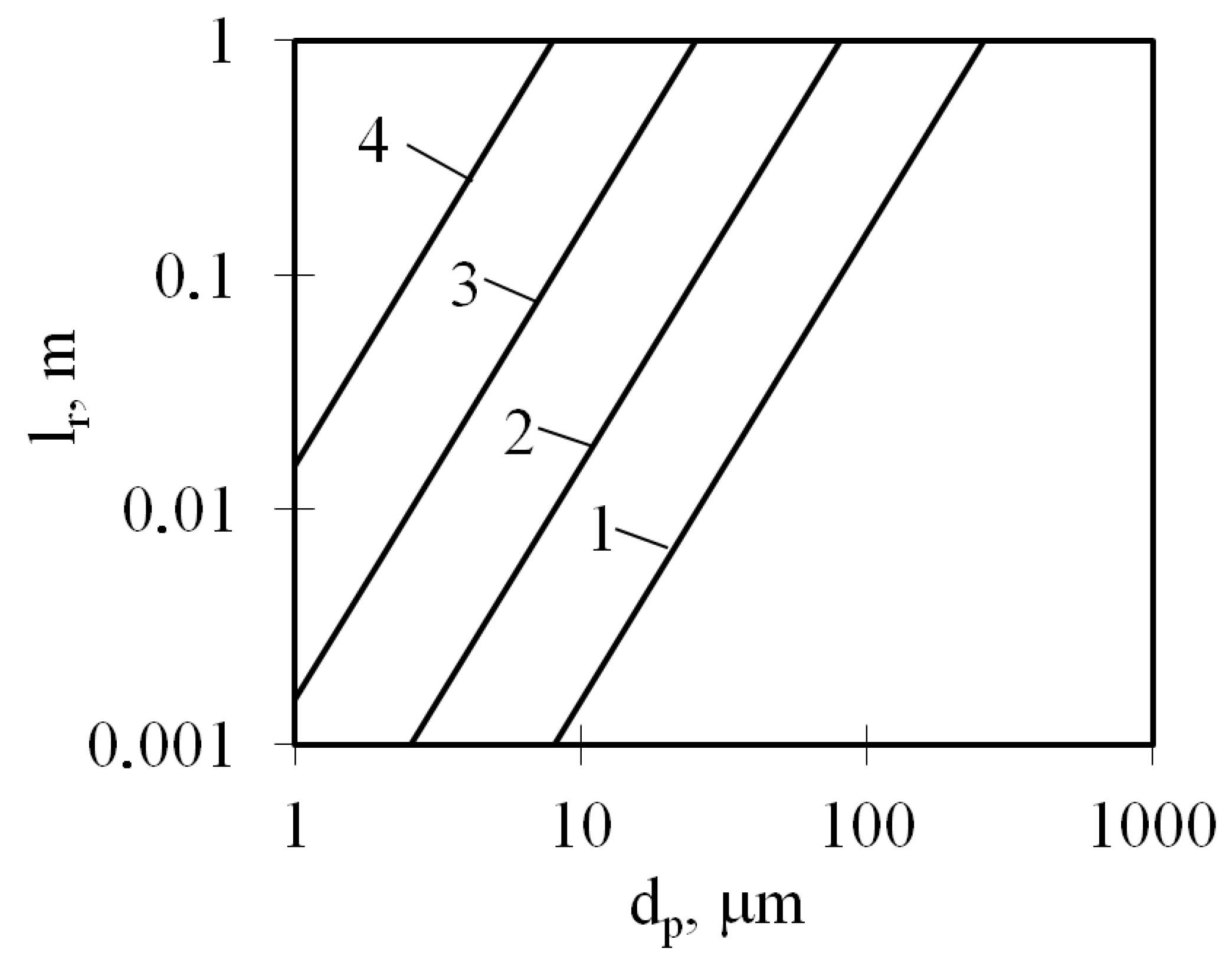
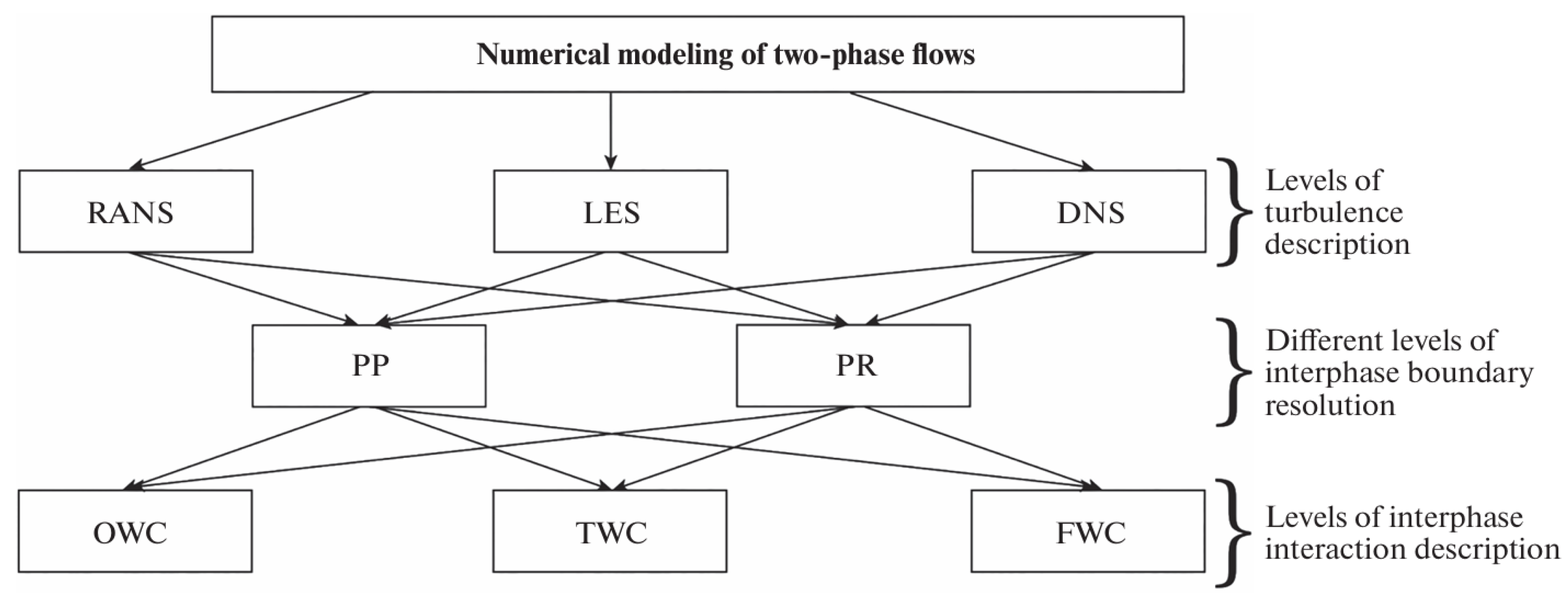
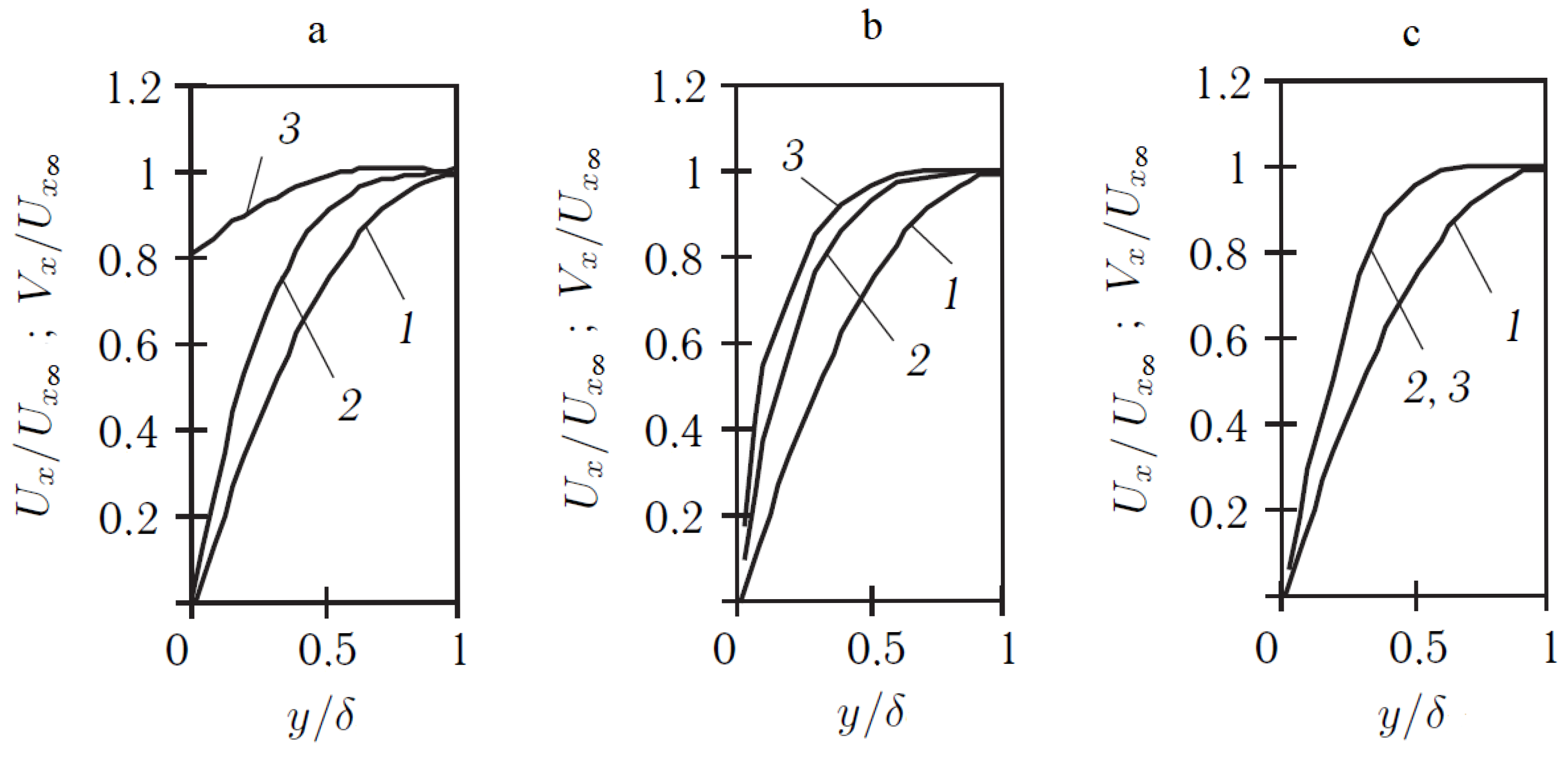

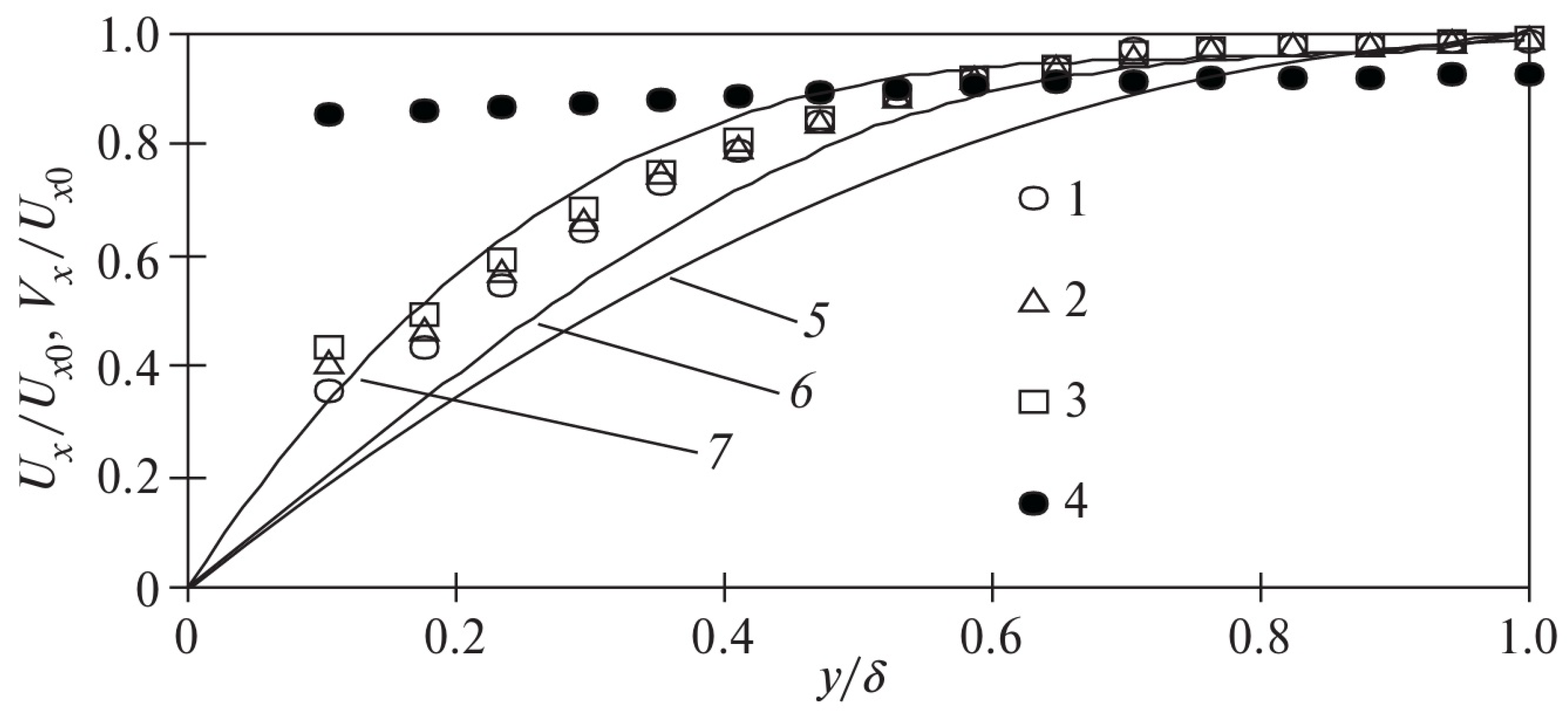
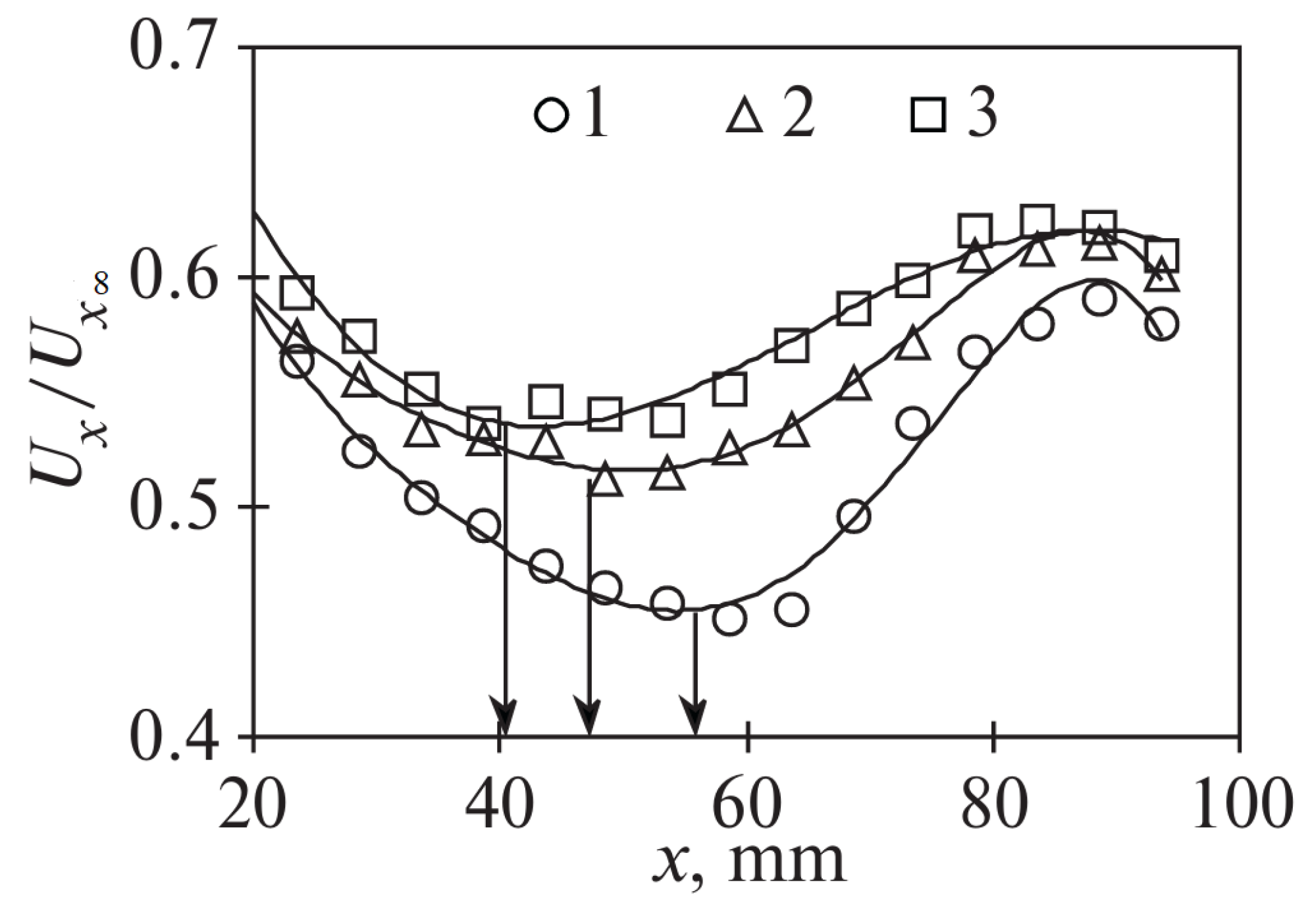
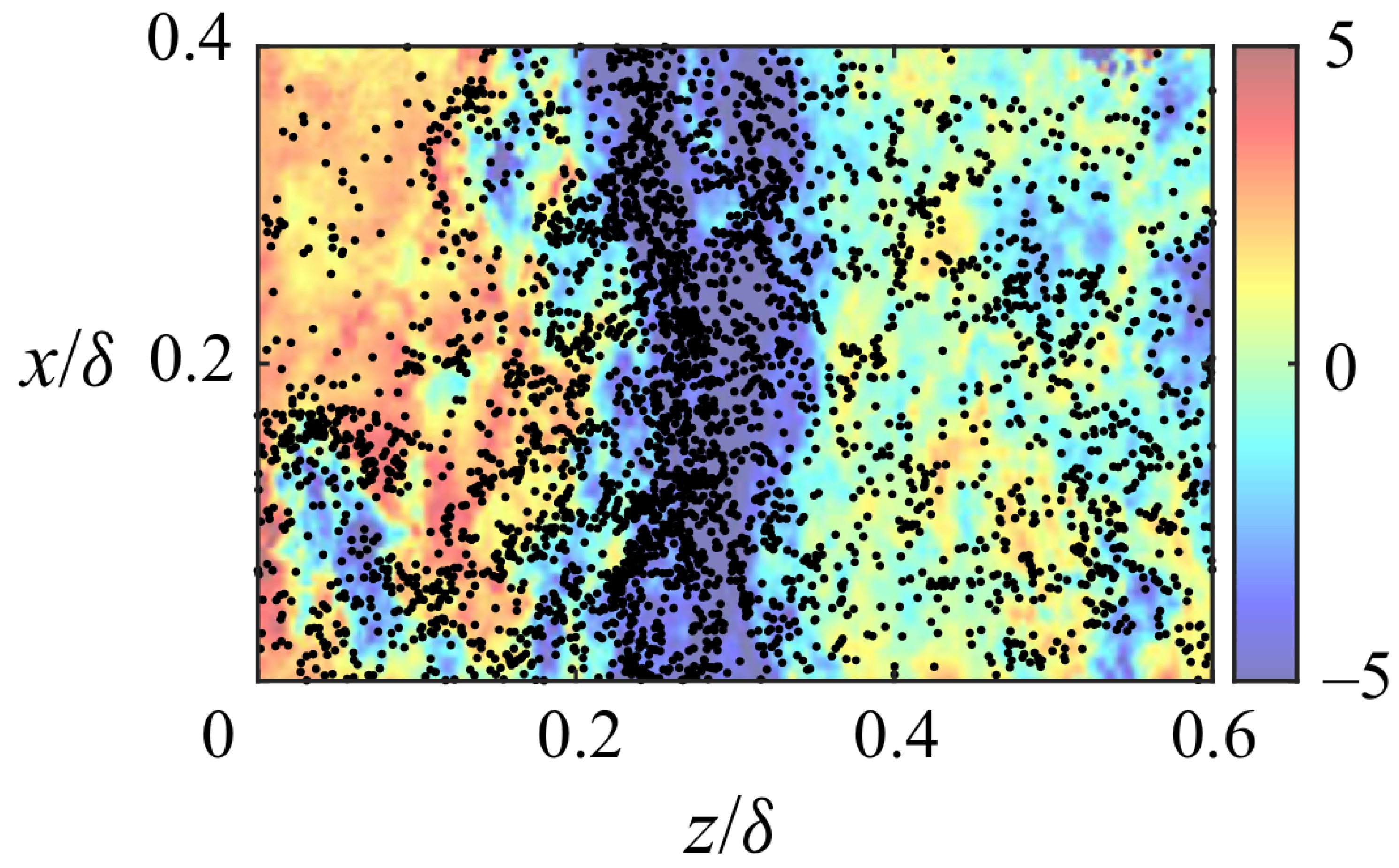

Disclaimer/Publisher’s Note: The statements, opinions and data contained in all publications are solely those of the individual author(s) and contributor(s) and not of MDPI and/or the editor(s). MDPI and/or the editor(s) disclaim responsibility for any injury to people or property resulting from any ideas, methods, instructions or products referred to in the content. |
© 2025 by the authors. Licensee MDPI, Basel, Switzerland. This article is an open access article distributed under the terms and conditions of the Creative Commons Attribution (CC BY) license (https://creativecommons.org/licenses/by/4.0/).
Share and Cite
Varaksin, A.Y.; Ryzhkov, S.V. Particle-Laden Two-Phase Boundary Layer: A Review. Aerospace 2025, 12, 894. https://doi.org/10.3390/aerospace12100894
Varaksin AY, Ryzhkov SV. Particle-Laden Two-Phase Boundary Layer: A Review. Aerospace. 2025; 12(10):894. https://doi.org/10.3390/aerospace12100894
Chicago/Turabian StyleVaraksin, Aleksey Yu., and Sergei V. Ryzhkov. 2025. "Particle-Laden Two-Phase Boundary Layer: A Review" Aerospace 12, no. 10: 894. https://doi.org/10.3390/aerospace12100894
APA StyleVaraksin, A. Y., & Ryzhkov, S. V. (2025). Particle-Laden Two-Phase Boundary Layer: A Review. Aerospace, 12(10), 894. https://doi.org/10.3390/aerospace12100894





